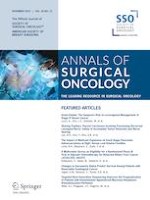Erschienen in:

05.08.2023 | Thoracic Oncology
Endoscopic Evaluation of Pathological Complete Response Using Deep Neural Network in Esophageal Cancer Patients Who Received Neoadjuvant Chemotherapy—Multicenter Retrospective Study from Four Japanese Esophageal Centers
verfasst von:
Satoru Matsuda, MD, PhD, Tomoyuki Irino, MD, MSc, PhD, Akihiko Okamura, MD, PhD, Shuhei Mayanagi, MD, PhD, Eisuke Booka, MD, PhD, Masashi Takeuchi, MD, PhD, Hirofumi Kawakubo, MD, PhD, Hiroya Takeuchi, MD, PhD, FACS, Masayuki Watanabe, MD, PhD, Yuko Kitagawa, MD, PhD, FACS
Erschienen in:
Annals of Surgical Oncology
|
Ausgabe 12/2023
Einloggen, um Zugang zu erhalten
Abstract
Background
Detecting pathological complete response (pCR) before surgery would facilitate nonsurgical approach after neoadjuvant chemotherapy (NAC). We developed an artificial intelligence (AI)-guided pCR evaluation using a deep neural network to identify pCR before surgery.
Methods
This study examined resectable esophageal squamous cell carcinoma (ESCC) patients who underwent esophagectomy after NAC. The same number of histological responders without pCR and non-responders were randomly selected based on the number of pCR patients. Endoscopic images were analyzed using a deep neural network. A test dataset consisting of 20 photos was used for validation. The sensitivity, specificity, positive predictive value (PPV), and negative predictive value (NPV) of AI and four experienced endoscopists' pCR evaluations were calculated. For pathological response evaluation, Japanese Classification of Esophageal Cancer was used.
Results
The study enrolled 123 patients, including 41 patients with pCR, the same number of histological responders without pCR, and non-responders [grade 0, 5 (4%); grade 1a, 36 (30%); grade 1b, 21 (17%); grade 2, 20 (16%); grade 3, 41 (33%)]. In 20 models, the median values of sensitivity, specificity, PPV, NPV, and accuracy for endoscopic response (ER) detection were 60%, 81%, 77%, 67%, and 70%, respectively. Similarly, the endoscopists’ median of these was 43%, 90%, 85%, 65%, and 66%, respectively.
Conclusions
This proof-of-concept study demonstrated that the AI-guided endoscopic response evaluation after NAC could identify pCR with moderate accuracy. The current AI algorithm might guide an individualized treatment strategy including nonsurgical approach in ESCC patients through prospective studies with careful external validation to demonstrate the clinical value of this diagnostic approach including primary tumor and lymph node.











